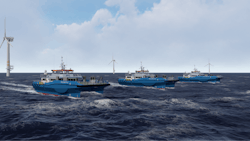Three SWATH CTVs to be built to new Ad Hoc Marine design
Offshore staff
SANDOWN, England, UK – Ad Hoc Marine Designs Ltd (AHMD) has announced that a new design of small waterplane area twin hull (SWATH) crew transfer vessels (CTVs) will be built for Maritime Craft Services (Clyde) Ltd (MCS). Initially, three vessels to the new design will be built at Työvene yard in Finland.
A SWATH ship is a twin-hulled vessel which concentrates a large proportion of its floatation volume into bulb-like hull sections deep beneath the waterline. These torpedo, or submarine-shaped flotation bulbs support the weight of the vessel through narrow, hydrodynamically efficient hull struts. In the case of the AHMD design, the CTVs will have additional motion stabilization with zero speed heave mode controllable fins.
The vessel’s engines, fuel, and other heavy equipment are contained within the upper haunch region for access and maintenance from the main deck, allowing the struts to only require minimal wiring and plumbing to pass through them, which enables them to be made narrow and hydrodynamically efficient, AHMD says.
The company adds that the main advantages of a SWATH hull form over a more traditional monohull or catamaran are twofold – the efficiencies derived from a low waterplane area and decreased vertical accelerations in rough sea conditions which allow a wider window of operation with more comfort for passengers and crew.
AHMD also says that this current SWATH hull form requires less than 50% of the power required by an equivalent size and displacement conventional vessel when operating at slow speed, thereby reducing fuel consumption and CO2 emissions.
02.25.2024
